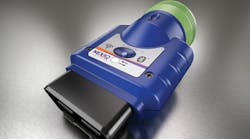When it comes to “putting together” a medium duty refrigerated truck, the goal is to end up with a refrigeration system and truck body designed to maintain – not change – the temperature for the products being transported, explains Chris Olson, director of product management for Supreme Corporation (www.supremecorp.com), a leader in truck body manufacturing that offers a full line of customizable truck bodies.
Not to be overlooked in the process is the packing of the products to be transported, he says, as this has implications on how easily and efficiently refrigerated products can be maintained at the optimal temperatures. Mass and packing density of the loads will dramatically impact the refrigeration requirements of the system, so how the load will be diminished over the duration of the route needs to be considered as well.
“When selecting a truck, it is critical that you maximize for volume,” add Chris Kroeker and Carl Breczinski, product managers with Thermo King (www.thermoking.com), a global leader in transport temperature control systems for a variety of mobile applications. “The more efficiently the truck is loaded, the better the return on the capital investment. If used inefficiently, money is wasted on cooling the space and the outlay for the vehicle. Around 90 percent loaded can be considered a good use of the capital investment.
“Currently, we’re seeing a trend towards customers selecting smaller bodies over time as they learn that they are not using space efficiently.”
They add that selection also depends on how certain a fleet is about the size of the load every day. For example, if it delivers goods from a bakery to a distributor daily, “you probably know exactly how much is going on the truck. But if you deliver to 10 different convenience stores every day, your load depends on what they order. In that case, you have to configure to the maximum you will need.”
NOT TO BE OVERLOOKED
Keep in mind that as a refrigerated truck ages, its insulation efficiency diminishes due to loss of dry gas in foam and moisture trapped in the structure, Supreme’s Olson says. It is not uncommon to have a 10 percent loss over three years, and that loss is higher in high-humidity climates.
When considering the dimensions of the refrigerated body, “remember that the overall exterior dimensions will vary to the interior dimensions based on the insulation packages selected,” he points out, and “interior dimensions are critical for airflow.”
By way of example, a truck body that has 5” of insulation will lose 5” of interior space on the sides, front wall, roof and above the floor.
Attention also needs to be paid to the types, sizes and quantities of doors needed. This is dependent upon the types of product being carried, style of loading or combinations of different factors
“Generally speaking, roll up doors are good for medium temperature low route density deliveries with dock loading requirements,” says Olson. “Frozen and multi-stop routes are better suited for swinging doors as they contain more insulation, seal better and are generally better ergonomically for repetitive openings.
“The use of strip curtains and door switches (to automatically shut refrigeration units off when doors are opened) is highly recommended on any refrigerated application with greater than one service factor. Up to 30 percent reductions in run-times on refrigeration systems can be realized from using both strip curtains and blower cut-out switches.”
ERGONOMICS
“Operator safety and ergonomics should be taken into consideration when addressing bumper and step selection,” advises Supreme’s Olson. “Frequency of use and operating conditions should be discussed also.”
Consideration should be given to whether a low-profile chassis – which keeps the body of the truck closer to the ground – would be beneficial. The lower height makes it easier for a driver to get in and out of the cab and truck body, but it is not suitable for those applications where dock height is required.
Some customers “are moving to smaller bodies that have reach-in sides and reach-in doors, which can be much easier to manage than larger trucks that require the more laborious process of pulling out a ramp and using a dolly to take out product,” add Thermo King’s Kroeker and Breczinski.
“In sum, an increased desire for ergonomic solutions can translate to an increased usage of smaller trucks,” they continue. “Safety plays a role in this trend too. If you are pulling out heavy ramps and it is icy out, injury can be more likely.”
TYPE OF USE
The variety of temperature-sensitive goods to be transported, separate compartments and dual-temperature systems are additional important criteria, and so is the amount of insulation and where the trucks are operated, say Kroeker and Breczinski of Thermo King. “If you are operating in Phoenix as opposed to Toronto, you are going to have different insulation needs.
“If your product is valuable, there is more to consider. For example, with vehicle-powered refrigeration, it cannot be guaranteed that you are always going to have a constant capacity, because the capacity of the unit changes with the speed of the engine. So most high-end loads – like pharmaceuticals – will have self-powered units to ensure that they have a constant capacity, unaffected by the traffic conditions.”
REFRIGERATION UNITS
Many aspects go into sizing a refrigeration unit, Thermo King’s Kroeker and Breczinski point out, including truck body size, insulation type and thickness, door type and adding strip curtains – all of which factor into how efficient the truck and the box is going to be from a refrigeration standpoint.
They note that when vehicle-powered reefer units are running in standby, they maintain typically about 80 percent of their maximum output when moving over the road.
Other considerations are how long the truck operates every day, how often its doors are opened and what ambient temperatures are going to be experienced. “The exact same truck hauling the exact same load in New York City and Phoenix could potentially need completely different truck units.”
CHASSIS
Obviously, having the proper chassis is paramount to getting the most performance, reliability and uptime from any type of truck, says Ramses Banda, product manager at Navistar International Corporation (www.navistar.com), a holding company whose subsidiaries and affiliates produce International brand commercial and military trucks, proprietary diesel engines, as well as IC Bus brand school and commercial buses. If the chassis does not “fit” the truck body, a fleet can expect unscheduled downtime, increased maintenance costs and upset drivers and customers.
“Fit” means matching the chassis to the body requirements, which includes the size of the body and payload capacity.
The chassis must be strong enough for this weight and for a liftgate – if one is required – and to handle the added stresses should the truck be loaded by a forklift. These things will help determine the chassis gross vehicle weight rating (GVWR), gross axle weight rating (GAWR) and appropriate chassis length, he says. In addition, the chassis powertrain needs to be spec’d appropriately to ensure maximum overall performance and fuel economy based upon operating conditions and application requirements.
Other chassis considerations:
- Features for driver comfort and safety.
- Air-ride or spring suspension.
- Long-life and reduced maintenance vehicle components.
- Ease of serviceability.
- Clean frame rails from the back of the cab rearward clear the way for quick and efficient installation of the truck body and any chassis-mounted equipment.
- Warranty.
- After sale service and support.
- Resale value (typically driven by the popularity and appeal of specific components or component packages).
It is always wise to visit with truck, refrigerated truck body and transport refrigeration unit and systems dealers for guidance and advice when spec’ing a medium duty refrigerated truck.




